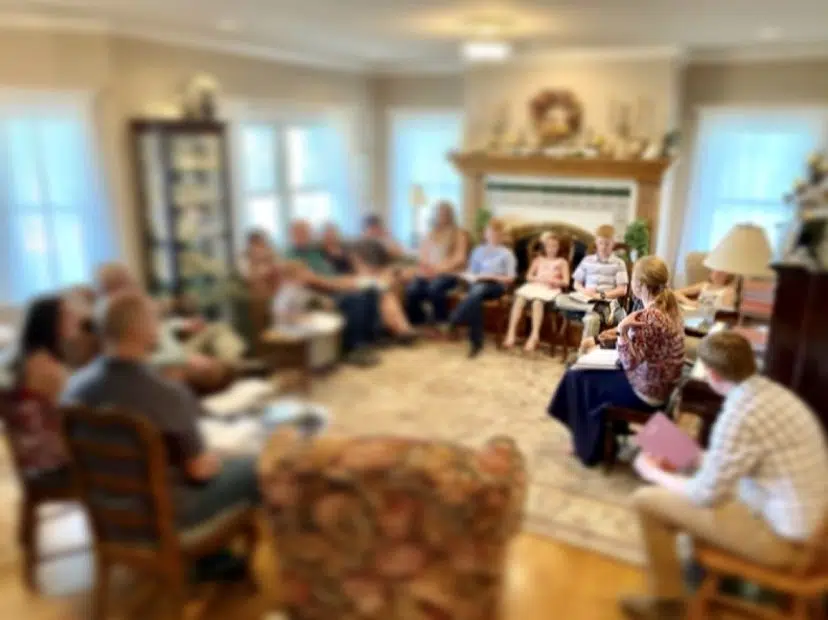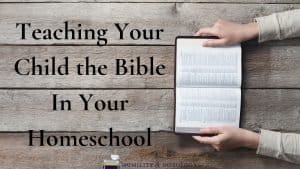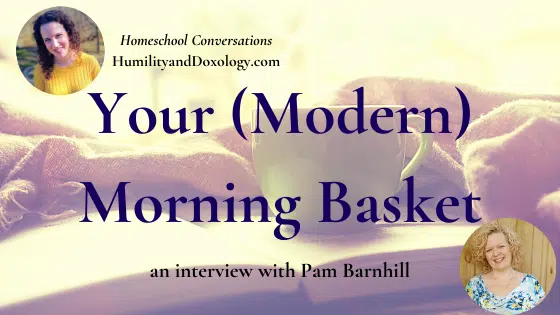So you want to sing Psalms with your children, but you’re not really sure where to start. Or maybe you wonder why singing Psalms with children is even important! Is Psalm singing really something to prioritize in family life?
Today my friend Melissa Cummings shares not only her personal experience and love for singing Psalms, but she also gives practical tips for including Psalm singing in the homeschool day. Melissa shares what she’s learned from her experience as a musician, music educator, and homeschool mom of many. Part memoir, part musical training, and part practical advice, this is a post you’ll want to bookmark and return to time and again! Thank you, Melissa, for sharing your wisdom with us!
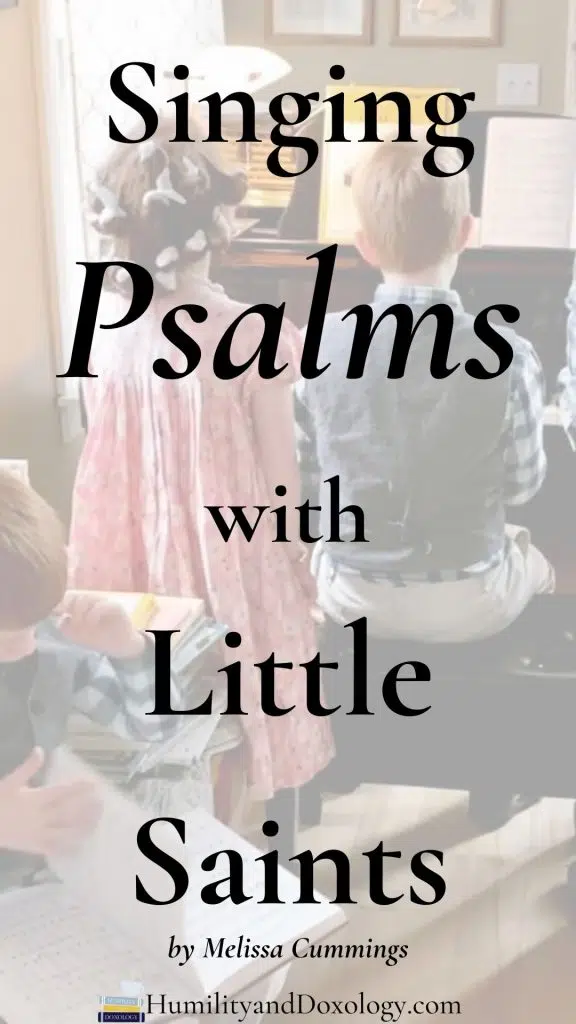
{This post contains paid links. Please see disclaimer.}
Singing Psalms with Little Saints
by Melissa Cummings
Let the word of Christ dwell in you richly in all wisdom,
Teaching and admonishing one another
In psalms, and hymns, and spiritual songs,
Singing with grace in your hearts to the Lord.
Colossians 3:16
Long before I became a mother, I yearned to have children who sang. During my own years of home education in a Reformed Christian family, we grew our love of hymns into a love of Psalms—a love of melody into a love of harmony—a love of corporate singing on Sundays into a love of singing at home as a family all week long. I loved almost nothing more than monthly Psalm sings with our church family—and to this day, there is almost nothing which fills me with more delight than filling my home with the echoes of boisterous harmony. This love, instilled during my own childhood, was something I longed to continue cultivating as I moved on to college academics and beyond.
While I had assumed I would pursue my instruments of harp and piano at University, I ended up pursuing vocal studies and found a deep passion for choral collaboration. I became convinced that the skills I learned in various choirs and chamber groups could be valuable in family life as well as church life, wherever the Lord led me after graduation. From my classes in sacred music to church history to children’s ministry, a common thread was strengthened for me—I was eager to absorb worship principles and practices which I could take forward into future callings to pass along my own passion and proficiency. I knew that if I did not want my future to be filled with watered down worship, I needed to take hold of historical richness and pray for opportunities to share it.
Fast forward about fifteen years: my moniker is now a Mrs., and God has blessed me with my own home choir of little saints—five children lifting their voices in song alongside me at home, plus our nine others gone before to sing around the heavenly throne. Since becoming a second generation Christian homeschooling mother, I have been delighted that the Lord has given me opportunities for teaching music—piano lessons, harp lessons, music theory, and what I have joyfully called Singing School. I am passionate about teaching others to make music, to sing with grace, and to let the Word of God dwell in us. I love to teach Singing School, a choir at its bones, with Christ at the center. He is the reason we sing. He is the one to whom, and for whom, we sing. As Saint Augustine said, “the one who sings prays twice.”

Teaching Children How and Why to Sing Sacred Music
Martin Luther said that “the noble art of music is the greatest treasure in the world.” We learn in Scripture that we should address one another “in psalms and hymns and spiritual songs, singing and making melody to the Lord in your heart.”
As Christians, we understand music in light of who God is, and we ought to use music to glorify Him and bless His Kingdom here on earth. As humans created in God’s image, we should pursue truth, goodness, and beauty in all our endeavors, for that is precisely what He does. One way to pursue this is by jumping into music full force—no matter your own past experience with singing, musical literacy, instruments, or corporate worship.
I believe that every Christian child should learn how to sing as an individual, how to blend together with others as one voice, how to sing God’s Word, and to begin growing an understanding that our singing is both an echo of God’s creation and a foretaste of heaven. I encourage families to embrace singing as a masculine art at its core, not simply a feminine grace. It is a Christian act, and Christ is certainly the epitome of masculinity—so we talk about singing with gusto (no matter the pitch), discuss how music is warfare, and take time to listen to classic boys’ choirs. Reading the history of Jehoshaphat in 2 Chronicles 20 is always a blessing—reminding God’s children that He calls us to go into battle with worship, with song. The king appointed the singers to walk ahead of the army, praising God for His majesty. If that isn’t a masculine art, I can’t imagine what is.
A few key elements to include when teaching children to sing
When working with kids, I like to give a brief introduction to conducting (where I wave my hands around to help keep time) and solfege syllables (do re mi…) along with corresponding hand signals called Kodaly. I always share a small glossary of terms that I may use now and then so they have answers to their questions before they even know what to ask. (A sample music glossary is included at the bottom of this post)
Whether the children knew this stuff previously or not, whether they catch on right away or not, we still have a great time singing together—and I think this is nothing less than a gift from God.
I emphasize that while we are getting acquainted with our voices, we will be making silly sounds, odd sounds, and even using our hands and bodies along with our voices. We learn how to breathe deeply in our gut, using our diaphragm well, not allowing our shoulders to shrug.
We learn to be bold in our singing, rather than shy, when using our bodies and our voices. It is okay to make mistakes. I tend to encourage the kids to make mistakes boldly, because then they are easier to identify and correct. I would never want my children or other students to seek perfection in singing on this earth. We seek excellence, which is measured by growth and joyful pursuit rather than by an imagined perception of perfection. We must be willing to learn new skills, have fun, praise God, and make mistakes together.
Learning new music, particularly when it is an unfamiliar style or form, takes hard effort and diligence. God Himself calls us throughout the Psalms to sing new songs and to sing with skill, so He will also provide us with the means to accomplish this.
I compile a binder of musical selections for my students at homeschool co-ops, in which there is an undeniably strong emphasis on singing Psalms and Scripture, as I am passionate about warfare through worship and praising God with His own infallible Word. The majority of the music I teach is taken directly from Scripture! May God’s Word be ever read, studied, known, memorized, and sung for His glory in our homes, in our churches, and in our families’ educational pursuits.
I often seek to work with music involving harmonic lines even for the youngest kids, largely using a form called canon (singing in a round). I first, however, focus on all unison melodies, as well as introducing some ancient church pieces referred to as service music. This class can feel like group vocal lessons, as the children learn how to make a joyful noise and/or sing beautifully. Regardless of their own perceived skill, this music-making is for everyone who calls upon the name of the Lord!
I love working with kids for beauty in sound, but my main goal right from the beginning is to impart a broad understanding of singing in a group and of bringing glory to God through united voices.
He put a new song in my mouth,
a song of praise to our God.
Many will see and fear,
and put their trust in the Lord.
Psalm 40:3
Practice is essential for any instrument, voices being no exception, to grow in skill and to memorize music. You don’t have to be able to read the musical notation to practice the music, although if you can at least read the words, that is a huge advantage. And if you know how to read the musical notation, more power to you! But do not be intimidated if it just looks like confusing lines and dots to you. We are made to be imitators, and even the youngest of children can imitate pitch and word.
Musical notation and music theory can be communicated little by little as you find it helpful (Black dots go up? Voice goes up! Black dots go down? Voice goes down!), but that is not the spine of the matter. When it comes to learning song, there is plenty of grace for every voice and every skill set. Simply apply your attention and your diligence, your patience and your joy. Approach the subject with humility and faith, and the Lord will undoubtedly bless the work of your hands—and vocal chords—in making a joyful noise.
Singing together is the quickest way to unite a gathering of individuals,
no matter how large or small, into one corporate worshiping body,
the body of Christ. Something happens when we sing.
—Leading the Church’s Song, Augsburg Fortress
The value of memorization through music
Of course, auditory learning paired with visual learning is the most highly effective way of assimilating musicianship and memorizing the lyrics. Having some method of listening to the pieces on repeat is very key, and something I highly encourage—there are countless resources online, on smartphone apps, and other recordings like CD.
I like to record my children singing, and then sing along with the replay—we can even learn harmony or canon more easily using that trick. The process of repetition and memorization, in fact, is why I emphasize psalms, hymns, and spiritual songs in musical training.

Our children’s minds are going to be filled with something—giving them the gift of treasuring the transformative words of Scripture and the truth-filled narratives of many hymns just logically follows as the most deeply rich gift we could give them. When we memorize such blessed things, they seep into the very memory banks of our bones like muscle-memory.
My grandfather, when dying of Alzheimer’s, could still manage to mumble out the Lord’s Prayer, Psalm 23, the Doxology, and Amazing Grace long after he could articulate anything on his own or communicate any recognition of even his wife or daughter. And in The Hiding Place, Corrie Ten Boom tells about the time her mother—having suffered from a stroke and being unable to say anything but yes, no, and Corrie from then on—was able to sing “Fairest Lord Jesus” from out of the blue at her daughter’s wedding.
What we sing matters. What we memorize matters.
It has often been said that the way in which we pray (lex orandi)
has great bearing on that which we believe (lex credendi).
It is probably just as valid to say that what we sing also shapes our faith—
lex cantandi lex credendi.
—Leading the Church’s Song, Augsburg Fortress
We need to teach our children how to keep their hearts with diligence, and explain the potency of what flows from that wellspring (Proverbs 4:23). Even things like brain disease and strokes (reminders of this fallen world wherein we yet live) can not subdue spiritual health and internalized riches (reminders of God’s grace toward His image-bearers). Information is well and good, but especially in a Christian home pursuing a Classical education, it is transformation which matters. This is by grace, in pursuit of wisdom.
Hearts Transformed by the Word of God Hidden in Our Heart Through Song
Praise the Lord!
Sing to the Lord a new song,
His praise in the assembly of the godly!
Psalm 149:1
Beyond the joy and work of teaching children to sing for the glory of God, emphasizing that transformation of their hearts as well as their memories is important. I fondly recall my father explaining that we did not subscribe to the exclusive psalmody tradition which argues that we sing nothing more than the Psalms in worship, but we ought not sing less than the Psalms. Essentially, he was saying that the Psalms are a necessary starting place, but we ought not be afraid of other hymns and spiritual songs when we praise God in the assembly of the godly.
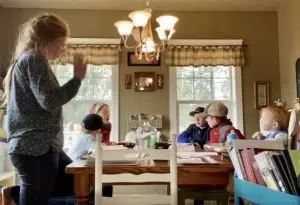
When I was a very small child, my dad would put Scripture to simple music that he wrote—he would type or scrawl them onto computer paper (remember the kind with the perforated edges, with holes down the sides?) and add guitar chords. He knew little about reading a musical staff, and I knew absolutely nothing about guitar chords—but we both loved memorizing Scripture together this way. The sweet predictability of singing together as part of my bedtime routine is one of my fondest childhood memories—and I can still sing many of the songs without much mental strain. My dad recently started teaching some of my children these songs, and so now I will occasionally hear the next generation carrying on this tradition, reminding me of 1 John 4, Philippians 2, Matthew 6 or Matthew 18 which portions I memorized by my dad’s knee as it steadied his guitar.
Be filled with the Spirit,
Addressing one another in psalms and hymns and spiritual songs,
Singing and melody to the Lord with your heart.
Ephesians 5:19
I think my mom bought every Psalty the Singing Songbook vinyl record out in the eighties, and we played them nonstop. I remember singing along at the top of my lungs, bumping the needle on the record player back to favorites over and over! I loved Charity Churchmouse, Blooper the dog, and Psalty’s trio of kids – Melody, Harmony, and Rhythm. I was also, for a few months every year, able to participate in the children’s choir at our church. I vividly recall the delight of finally getting to put on the t-shirt which showed that I had joined the New Creature Choir.
These were simple yet profound introductions in my childhood to choral work as well as singing of Psalms. I had no idea (nor, I think, did even my parents) what seeds were being planted at that time.

As a family, we were introduced to more formal psalm singing about a decade into my life, and we dove in deep—loving it, embracing it, desperately wanting to cultivate skill in it. One of the first resources we used was The Book of Psalms for Singing—a lot of the simplest psalms for us to learn were set to hymn tunes we already knew: For the Deep, Deep Love of Jesus; Jesus Shall Reign Where’er the Sun; Rejoice, the Lord is King; Amazing Grace… there was a treasure trove of easily accessible arrangements there, which eased us into the practice with a musical familiarity even when the text felt sometimes backward or forced. I was determined to play piano through that entire psalter as quickly as possible, and I know I had done it before my thirteenth birthday. Then I decided that I wanted to sing through the entire thing—that took much longer, but I did it!
Once my new favorite psalter-hymnal, the Cantus Christi, was published in 2002, I again set out to do the same thing: play through the entire book on my piano, and then work through singing the entire thing. I have done it a few times in my life now, and it continues to feed my soul and bless my family. My children beg me to play piano for them after they are tucked into their beds at night with books and flashlights. Sometimes I hear them tiptoe to the stairwell, clad in jammies, humming or singing along. It is hard to send them back to their beds when they are drawn to the music like that! They are meditating on the Word when they lie down; Scripture, set to tune, is being inscribed on their hearts and minds.
In 2020, I welcomed the second edition of Cantus Christi into our home by playing through the entire thing, and am currently working my way through the Trinity Psalter Hymnal as well (I’m through the psalms, and am nearly through the hymns at this point).
This familiarizes me well with the tunes—melody and rhythm, lyrical depth and musical richness—so that when I am ready to sing new songs with my family, I am not coming in completely blind.
I remember choosing two favorite Psalms for congregational singing at my wedding in 2007—Psalms 45 and 128—and how adding a hymn into the service was more of an afterthought to me because the psalms really had become such a normal nourishment in my life and times of worship. I definitely didn’t let it bother me that half of the pews that day were filled with people unfamiliar with singing Psalms and coming in blind to those pieces. I have a photo of my dad and me belting out Psalm 45 with apparent gusto, and while much of that glorious day has faded in my memory, that is still a moment that remains both strong and sweet.
Including Psalm Singing In Family Life
The Psalter is the very paragon of books.
—Martin Luther
When my oldest child—now thirteen—was a small baby, I began to spend a little time with him (most mornings) singing, reading a Psalm & an excerpt from Proverbs, and then reading aloud to him. Life was just the two of us while my husband was away at work for the majority of our days, and although I would sing Psalms during almost every nursing session, it was the time of “lovely things on the couch” where I really emphasized its importance. I had no idea who Cindy Rollins, Pam Barnhill, Sarah Mackenzie, or the Scholé Sisters were back then—I just did what I thought was natural with my child, bringing him with me to the feet of Jesus and into a home culture of Christian beauty. I remember thinking of it as the best way to train him for Lord’s Day worship—teaching him the balance of sitting quietly, listening, standing, responding, singing, reciting. What better education to begin in infancy? I eventually learned that what I was doing would be broadly referred to as Morning Time, and the spine of it for me personally began with Psalms.
Two years ago when my youngest child was born prematurely, I would spend countless hours in the NICU with my tiny baby snuggled against my chest, careful not to mess with the tubes and wires to avoid making alarms go off—and I would quietly sing Psalms in his ear. I didn’t have psalters or hymnals at my disposal, and use of personal electronics in the NICU was strictly discouraged—so I relied on my store of memorized Psalms and hymns to give me words to sing. I remember specifically bathing my little preemie in Psalms 23, 63, 103, and 121 on a recurring basis.
And as we have had a handful of Christian friends imprisoned in recent months for things as common as worshipping God corporately or singing the psalms in a parking lot, it has been a fresh reminder that not only is this a potent tool against darkness, but it is also a gift—these men did not have psalters or hymnals in their pockets behind bars, but they had the words and tunes memorized, so they (like Paul and Silas in Acts 16) could lift their voices even then. I know that my children and grandchildren need that same gift, and I will do my utmost to equip them as God provides.

Psalm Singing in Our Morning Time Collective
As I continued homeschooling my children, our Morning Time routine has continued to be an important cornerstone in our family culture and educational pursuits. We have grown to call it Collective, where we collect our favorite people and favorite things together to engage one another collectively in truth, goodness, beauty.
What began as one on one time with my firstborn, and only took twenty or thirty minutes a day, has matured over time into a rich practice of up to two hours with my five children on a regular basis! (We also bring it into our local Classical Christian homeschool co-op now, for another glimpse into God’s great grace.)
To nobody’s surprise, the largest portion of our Collective practice is spent on singing. We have long had a hymn of the month, where we spend an entire month studying and singing and memorizing one hymn at a time—but we can never stop with just one, so we also review them a few at a time. And a couple years ago I began to lead my children then in a Psalm of the month as well, where we do the same thing.
What am I to do?
I will pray with my spirit,
but I will pray with my mind also;
I will sing praise with my spirit,
but I will sing with my mind also.
1 Corinthians 14:15
We have begun to share little snippets of our practice doing this on our @SacredPsalmody Instagram page. My children love to choose the psalms we assign to the months, but since four of them are still fairly opinionated and forthcoming about their preferences, sometimes I cast the deciding vote. I sure do love to see their passion on this subject!
I have had numerous people ask me how in the world I have “made” my kids learn to sing the way they do, and love to sing the things we do—friends ask to come over and join us so they can learn beside us. I think a lot of it boils down to family culture and educational emphases. Books and music are the mainstay of both in our home. I have cultivated this practice with my children over their lifetimes, and I have shared my love of these things with them. I have given them exposure and opportunity to grow in skill and love of important things, and they learn to love the things which I exemplify as being good, worthy, lovable. But I have not forced, rarely coerced, and only very occasionally bribed them to plunge onward in this pursuit with me.
My 5, 8, 9, and 13 year old children sing confidently and joyfully in four part harmony on a regular basis. The Lord has ever so graciously fulfilled the desire of my heart to have a home full of singing children! There were years where I grieved deeply the dream of having that—recurrent miscarriages filled my home, and Psalms of lament were my theme—Psalms were the only thing I could even think to pray. The Lord caused me, crushed to my marrow, to lay down my deep longing of having a little family band, a chamber choir… and to my surprise, He has redeemed and restored the years the locust had eaten. His faithfulness and merciful generosity toward me is daily evident, our loud harmonies an Ebenezer—a stone of remembrance—as a physical reminder of spiritual truth and the surprisingly ordinary kindness of God in the details.
As I have had these questions of “how?!” repeatedly asked, though, I have been reminded fairly regularly that what is normal in my home may not be considered quite so normal in others. If there were any way our Sacred Psalmody page or my Singing School class could just transport you into my home for a day, I would gladly show you the ropes, and open your eyes to the tools God has already given you.
If you feel unequal to the task or ill-equipped to lead your children in singing, I just want to hold your face in my hands and assure you that the Lord gives you what you need.
Do you have the psalms? Do you have a voice? Then you have enough to start.
But just because God is so abundantly generous, He has also given us much more than that in the 21st century.
I hope to now give you some tangible help, resources, and practical encouragement: you too can lead your little saints in singing the psalms.

Practical Tips and Tools For Teaching Your Children to Sing Psalms
WHAT Psalters We Use
We have a variety of psalters and hymnals at my home, but the ones we use most regularly for singing the psalms with our little saints are The Book of Psalms for Singing, Cantus Christi (both the 2002 and 2020 versions—yes, they are different!), Cantica Sanctorum (if you don’t have the Cantus Christi 2020 version, pick this up—but you can find most of its pieces also included in the newer Cantus Christi), The Trinity Psalter Hymnal, and—our newest addition—the Theopolis Liturgy and Psalter. I am a devoted book girl, so I have not used a digital psalter myself, but have heard that Psalter.org is a blessing if you want to carry around some psalm singing options in your pocket.
WHEN We Sing Psalms
The absolute most common time is during our Collective, which is generally 4-5 times a week, often in the morning after chores & breakfast but before the heavier homeschooling begins. Sometimes we don’t get it done until the afternoon, and it is a nice interlude in the day… but I think we focus better and sing better when it is pursued earlier.
I know a lot of people encourage things like math and science to be done first thing in the morning when brains are most perky, but I think my children and I function best when we begin our day focusing on Scripture and song and other lovely things. I also love singing psalms in the morning, because I frequently catch my kids humming or whistling or singing the pieces later throughout the day as they go about their other tasks. There is nothing quite as precious as hearing psalms escaping the mouths of my children while they wash dishes, mow the lawn, or figure math equations.
We also sing in the car—especially if it is a short enough drive that we don’t turn on our current audiobook—and while we go on walks and when we visit the homebound or elderly. When we have committed songs to memory, we are not limited to singing at only the moments when we can hold the psalter/hymnal and focus our eyes on the page.
HOW We Include Psalm Singing in Our Day
Making this a known routine and frequent habit is the key. Also, having Mama pursue it with levity and joy while also balancing that with reverence and skill—I set the tone (no pun intended), and the kids follow my example. If I am grumpy, they will reflect that in their singing. None of us will be living out the lyrics we are singing. My husband is not regularly involved in the singing and memorizing, but he is extremely supportive of it and cheers us on. When he is able to join us, he sings a fine tenor with gladness and gusto! But even though their father is not able to join us in our daily singing practice, my sons have never thought that singing is girls’ work—they know it is simply the work of Christ’s people. Their father and grandfather set them a bold and winsome example every Sunday morning!
Reading aloud the Scriptures which show how God used music in the Old Testament—in the lives of Jehoshaphat, King David, Joshua,…—is an excellent way to remind us of the importance of music, of joyful noise, of trusting worship, of musical obedience. What was the hymnal of that time? The psalter! What did the people of God sing? Certainly Psalms, for starters! (Maybe we should too…)

WHO Participates When We Sing Psalms
Everyone who is home and available participates. If the baby is sleeping, we leave him be. If my husband is working, we tell him about it later. If my teenager is working away from home, he will catch up with us the next time. But when Mama says it’s time for Collective and begins handing out hymnals or sheets of music—you finish what you are doing, and you gather together. This isn’t an optional thing for the times you happen to feel like it. We habitually pursue it with gladness, and that eventually results in a harvest of feeling like it.
My friends at Scholé Sisters have often said that exposure breeds taste—and I think this is true of music in general, and singing Psalms specifically. It saddens my heart to see children in church pews who aren’t joining in the congregational singing, taking advantage of that weekly exposure. The training for Sunday mornings starts at home! If you do not show your children how to worship, and set the example of glad singing, it should be no surprise that your children become passive pew warmers on the Lord’s Day. If your child cannot read, they can still join in the praise to the best of their ability—reading words and reading notes can come later. In the meantime, encourage even your smallest family members to lift their voices! Practice at home so the words are familiar, if not memorized, and the whole family can be acquainted with the tunes. Singing psalms to tunes your children already know is a great tip, too.
WHERE To Find Additional Psalms Singing Resources
If you feel uncertain about singing acapella, try it anyway! Yes, I mean it. Even if you believe that nobody in your family can carry a tune in a bucket, you can still raise your voices together in joyful noise. Not every family has a house full of natural-born musicians: but every family is made up of natural-born singers. Being an image-bearer means you are to be a singer. Sing out of tune with boldness and gladness; work to grow your pitch-matching and musicality; but remember that regardless of your talent in musicianship, you are called to sing. You have a voice: lift it up!
But if you wish you had accompaniment, that’s okay too because there are plenty of additional resources to bring you along. Some families are better able to sing with confidence and worship the Lord with glad hearts when there is accompaniment, but not every family is blessed with a well-equipped pianist or guitarist (or trumpeter or whatever). In our modern digital age, we have online resources at our fingertips and app resources in every purse or pocket.
When my children were smaller, before we discovered our addiction to audiobooks, we played Jamie Soles music nonstop in our home and car. Highways to Zion, Pure Words, Ascending, and Songs from the 40s-50s-60s were albums that helped us sing and memorize many psalms. Nathan Clark George, Sons of Korah, and The Psalms Project are other artists that help fatten up our Psalm CD collection in a variety of musical styles.
We have a set of CDs from Canon Press called Worship in Harmony which teaches four-part harmony to some old favorites: different discs have different voices, and if you have someone in your home who wants to learn a particular part but nobody to teach it, this is a great resource to pair with a Cantus Christi.
My children have enjoyed using an app called Sing Your Part with my father—especially my second son, who wishes he could sing bass like his Grandpapa—so they use the app to learn the part together (my son singing it an octave up). I have heard good things about other similar apps, so I know there are a variety of options popping up out there in the tech world!
In fact, if you want to carry around multiple Psalm singing options in your pocket, check out Psalter.org for some great ideas. Or if you prefer a curated kickstart, Crown and Covenant has a Starter Kit that might be just the thing you need to walk your family gently into the beautiful practice of singing the psalms.
WHY Is It Important To Sing Psalms With Our Children?
Not to put too fine a point on the matter: Scripture tells us to sing, and certainly we ought to begin with singing the songs God has given us in His very own Word. As people of God, we ought to be people who love His Word, and delight in singing His Word. We do not need to stop there, but we ought to at least begin there.
Especially as a Christian mother, and a homeschooling one at that, I am deeply convinced that one of my main occupations ought to be bringing my children to worship their heavenly Father. This necessitates bringing them to the weekly Lord’s Day service, which is a cornerstone of Christian family living, but it doesn’t end there.
It is not enough to bring our children once a week to the feet of the Lord. We ought to delight in bringing our children daily to His feet.
My own children do not consider that they have to sing to the Lord and read His Word—they know it is a treasure and delight, because that response has been exemplified to them—they rather know that they get to do these things. Studying the lives and practices of Christians throughout history (books by Richard Hannula fall into this category for us) is a wonderful way to improve our perspective and teach our children to embrace the gifts of corporate worship, corporate singing, corporate fellowship—as well as practices of personal piety and familial song and worship.
I find great encouragement in these areas from multiple sources, but recently a series of posts from the Theopolis Institute challenged and blessed me. I continue to grow in my own understanding of how to implement habits of faith as well as why it is imperative and essential… and one of my favorite resources is simply to go back to the psalms themselves. I read the book of psalms on continual repeat with my children, and the themes of worship, adoration, and song are central throughout all 150, no matter what the particular theme or context of each.
If you ever wonder why you ought to sing, and bring your children with you into these songs, I encourage you to start with reading the psalms. And then I would challenge you to sing them—it is simply the natural progression which will follow once you have read them and meditated upon their content.
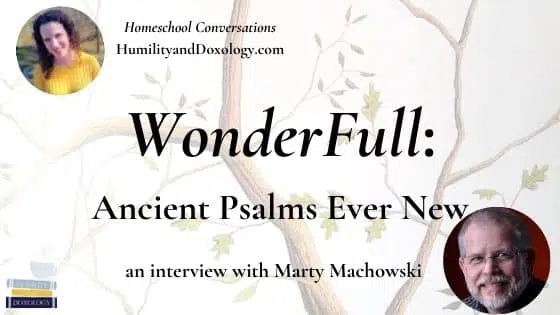
Serve the Lord with gladness!
Come into His presence with singing!
Psalm 100:2
As I finish composing these words to encourage and exhort you to sing psalms with the little saints entrusted to you, I have just returned home after spending an entire week with my children at a music camp: five full days of choir rehearsals, sectionals, folk dancing, Bible study, fellowship with other Christian kids… culminating in a ball on Friday evening and a choral concert on Saturday afternoon. Before coming home on Sunday, we attended church with friends where more than three hundred voices were lifted in song—psalms, hymns, spiritual songs. There was harmony reverberating in the floorboards and melody spinning around the ceiling beams. I wish I could describe the glad reverence on the faces all around me, but what struck me most was the joy in our very own row. My children—exhausted from the hard work and good blessing of a full week of physical and spiritual exertion—could not have been more engaged and worshipful. They know they belong to the Lord. They know it is their duty and honor and blessing and joy to worship Him. They know the exhilaration of singing well for His glory. And they delight in joining the host around them, the host above them, the host upon whose shoulders we continue to build.
All this morning, I can not quiet the voices of my four oldest children who are continuing to belt out their favorite music from the last week—some in Latin, some German, even some Swahili—but mostly what I hear is Scripture. Psalm 148 is currently echoing down the staircase. Psalms! And a loud amen from my two year old at every pause in his siblings’ song. Out of the mouths of babes.
Please join me in the pursuit of sacred psalmody in our families, homes, and resurging in Christian churches. If you would like to have a conversation about these things, please find me at JoyfulDomesticity.com or on Instagram @SacredPsalmody. I would love to walk with you through the process of bringing Psalms into your home and into the hearts of your children. Let us sing the psalms gladly with our little saints for the glory of our great King.
I will bless the LORD at all times;
His praise shall continually be in my mouth.
My soul makes its boast in the LORD;
let the humble hear and be glad.
Oh, magnify the LORD with me,
and let us exalt His name together!
Psalm 34:1-3

Melissa Cummings, alongside husband Steven since 2007, is a second generation Christian homeschooling mother of 4 sons & a daughter (and nine other children ahead in glory). She holds a BA from Whitworth University, which she attended after a life of home education in a Christian family. Educating her five redheaded children at home in rural northeastern Washington is now her full time work including banter & beauty, culture & cooking, music & mayhem, reading & recreation, trivium & teatime, worship & wonder. And did we mention books? Lots and lots of books. She loves to encourage and connect with others through writing, by prayer, and in the annual ministry of planning, coordinating, & pulling off the Paideia Northwest conference for mamas raising kids for Christ. You can find her at JoyfulDomesticity.com or anywhere you connect with Paideia Northwest.
Brief Pertinent Musical Glossary
aka things I want my children & students to know—bit by bit
- A Cappella: singing without any instrumental accompaniment
- Accent: stress or emphasis on certain notes/beats
- Accompaniment: the instrumentation that plays beneath the singing
- Accompanist: the musician who plays music beneath the singing
- Alto: typically the lower voice of the treble clef; second highest voice in 4-part harmony
- Bass: typically the lower voice of the bass clef; lowest voice in 4-part harmony
- Beat: the unit of musical rhythm
- Blend: in solo singing, the smooth transition between the head voice and chest voice. Or, when more than one individual is singing, the sound combination between singers, which preferably makes it difficult to pick out one singer’s voice amid the group.
- Break: the sudden change in tone between the head voice and chest voice, caused by vocal tension
- Breath support: efficient use of the singer’s stream of breath, controlled by your core and the diaphragm
- Canon: a musical form where the melody is imitated by individual parts at regular intervals, as a round. It could also be played at different speeds, backwards, or inverted.
- Chest voice: the lower notes of a singer’s range; in the same general range as the speaking voice
- Choir: group of voices singing as one
- Composer: the one who composed the musical setting
- Conducting patterns: hand motions used to indicate tempo, meter, volume, and interpretation
- Consonant: a speech sound produced as the result of a temporary partial or complete constriction of airflow (b d f g l etc)
- Crescendo: to get louder
- Decrescendo: to get softer
- Diction: the clear pronunciation of text
- Dynamics: the degree of volume (loudness, softness)
- Flat: to be under the correct pitch, not quite in tune
- Harmony: a pleasing combination of two or more sounds/pitches sung or played simultaneously
- Head voice: singing in the higher part of the range, usually lighter and brighter sounds
- Hymn: a religious song or poem often used in worship of God
- Kodaly: (see below) hand signs to connect visual and spatial connection to solfege syllables
- Legato: singing smoothly, as though the notes were tied together, flowing
- Measure: the units of measure, dividing the musical score with bar lines into sets of beats, such as 2 or 3 or 4 per measure
- Phrase: a single line of music played or sung; a musical sentence
- Phrasing: refers to the breaths or “stops” in between notes. Natural phrasing includes “stops” after all periods, commas, semicolons, or colons. Additional phrasing is necessary when a singer needs a quick breath or to achieve a certain unison style.
- Pitch: the sound (highness or lowness) of a particular note
- Psalm: a book of the Bible in the Old Testament that was essentially the hymnal of God’s people from the Israelites through the Early Church; a song either directly taken or paraphrased from the book of Psalms
- Range: refers to the notes that an individual can sing comfortably
- Repertoire: the songs the individual or choir knows and can perform well
- Rhythm: the element of music pertaining to time, as a grouping of notes into accented & unaccented beats
- Scale: a series of notes differing in pitch according to a specific pattern (we focus on the do-re-mi-fa-sol-la-ti-do scale, otherwise known as a major scale)
- Service music: pieces of music typically used in particular sections of a liturgical worship service
- Sharp: to be above the correct pitch, not quite in tune
- Sight singing: the ability to look at a piece of music and sing it at first look with general accuracy
- Solfege: (see below) a series of syllables (such as do-re-mi-fa-sol-la-ti-do) which teach tonality through a movable do
- Soprano: typically the higher voice of the treble clef; highest voice in 4-part harmony
- Staccato: the opposite of legato; each note is separated with a glottal “stop” from the note before and after
- Tempo: indicating speed
- Tenor: typically the higher voice of the bass clef; second lowest voice in 4-part harmony
- Transpose: to change the key of a song; to lower or raise the notes into a different range
- Unison: more than one voice or instrument playing the same thing at the same time; one sound
- Vowel: the resonating space in the mouth where the sung tone is sustained; ah oh eh ee oo
- Warm-up: anything that helps the vocal chords loosen up, as well as the jaw, the tongue, the palate and neck muscles. Typically various vocal exercises, such as running scales, humming, siren sounds and meowing, lip buzzing, gravel throating; also sometimes including warming up the body, including arms, hips, neck, shoulders.

